(strength
per strand = 22.5 kg, stretch = 2.6%)
Because of its durability, this material is used mainly on beginners equipment and
compound bows fitted with steel cables. It is easy to maintain and can
last several years.
Kevlar 7-11
(strength per strand = 31.8
kg, stretch = 0.8%)
This is a material with higher density, smaller diameter and lighter than
Dacron which will give a faster arrow speed. (approx. 2 metres per
second).
There are two problems with this material, the first is due to its
limited stretch which causes increased stress in the bow limbs.
The second problem
is its durability. The bowstring may only last 1000 shots before breaking
as it tends to fatigue due to bending at the nocking point.
Check with
the bow manufacturer if a Kevlar bowstring can be used.
Fastflite
(strength per strand = 45.5
kg, stretch = 1.0%)
This is one of the newer materials that can be used. It has the durability of
Dacron and even greater arrow speed than Kevlar as it is lighter.
As the
material has less stretch than Dacron, it is advisable to check with the
bow manufacturer, if it can be used.
It is made from a polyethylene derivative giving it a 'plastic' look and
feel. It is also very slippery, so the servings have to be wrapped very
tight otherwise they will slide.
Special serving material has been developed to help overcome this problem.
Fastflite S4
(strength per strand = 73 kg, stretch = less than 1.0%)
This is the latest material on the market. It is made from a composite of 50%
Fastflite and 50% Vectran making the strands thicker.
Therefore approx.
half the number of strands are required as for a Fastflite string.
Brace Height Tuning
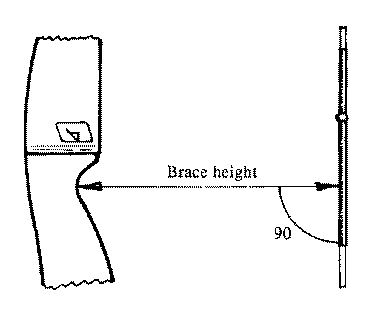
Brace
Height is measured from the centre of the bow grip to the bowstring at 90
degrees.
Most bows will have a recommended given by the manufacturer.
If the brace height is not known, then a rough guide for recurves is:
- 70 inch bow = 8.50 to 9.75 inches
- 68 inch bow = 8.25 to 9.50 inches
- 66 inch bow = 8.00 to 9.25 inches
- 64 inch bow = 7.75 to 9.00 inches
The ideal brace height for a bow is one that produces the quietest release
with the least amount of vibration in the bow.
Step 1
Set the brace height at the
bow manufacturer's recommended minimum.
A slightly longer bowstring may
have to be used as the bowstring must still have enough twists in it to
keep it round.
Step 2
Shoot a few ends of arrows at close range and
note how the bow performs.
Step 3
Increase the brace height by putting 5 more
twists in the bowstring.
Make sure to twist in the same direction as this will shorten the
bowstring. Also check and adjust the nocking point position.
Step 4
Shoot another few ends of arrows and note how
the bow performs.
Step 5
Repeat these steps until the recommended
maximum brace height is reached.
Step 6
Somewhere between the minimum and maximum
heights, the bow should perform at its quietest and with least vibration.
Where it does this, is the ideal brace height for the bow with this
particular type of bowstring. Keep a record of this brace height for
future reference.
To help your shooting, the
brace height must remain consistent. Any variation in distance will effect
the arrow flight, so always check the brace height before shooting.
Bowstrings stretch over time or broken strands can lower the brace height.
Arrow Nocking Point
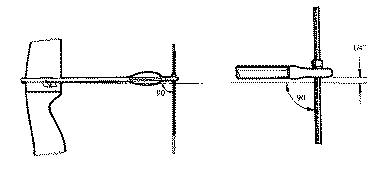
To obtain
correct arrow flight, a point on the bowstring must be found at which the
force from the bowstring acts directly inline with the arrow.
A starting point is generally somewhere between 3 to 10mm (1/8th to 3/8th
inches) above 90 degrees to the arrow rest.
This position is due to using two fingers below the arrow and one finger
above the arrow to pull the bowstring
and seeking to find the balance
point of the forces on the bowstring.
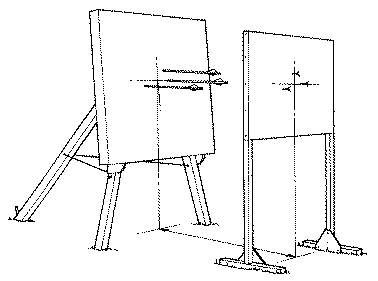
Step 1
A quick
way to tune a Nocking Point location is to use the 'Paper
Tuning' method.
A frame is placed about 2 metres (6 feet) in front of the target.
A sheet of paper is placed taut over the frame.
The archer then stands about 1 metre (3 feet) in front of the frame and
shoots the arrows through the paper.
From the direction of the tear in the paper, the nocking point can be
adjusted.
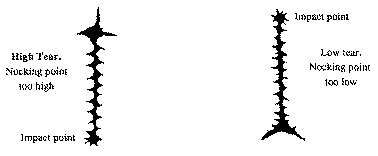
The paper tear
on the left indicates that the nocking point is too high.
The paper tear on the right indicates that the nocking point is too low.
Step 2

Adjust the nocking point location indicated by the direction of
the paper tears above.
Shoot through a new sheet of paper and check the direction of the paper
tears.
Keep repeating until the smallest paper tears are achieved.
Acceptable paper tears are shown in the picture at left, as perfect paper
tears may not be possible due to other factors.
Step 3
Note the exact nocking point location for future reference.
Always check your nocking point location before shooting.
If you can't get the paper tears to look like those
above, it may be that your arrows are 'under-spined' - too small for the draw weight
of the bow.
Pressure Button

Pressure
buttons usually come with three different insert springs - a soft spring, medium spring and hard spring.
For tuning, it is best to start with the medium spring and adjusting the
thread to the rear of the spring to about half way in.
Adjust the 'Centre-Shot' position of the arrow on the arrow rest by
winding the plunger button into or out of the riser.
To do this, nock the arrow on the bow, then looking from the rear of the
arrow, align the bowstring with the centre of the top and bottom limbs,
then check the alignment of the arrow shaft to the bowstring.
For bows shot with fingers, the correct alignment should be 'Outside
Centre-Shot' position.
Only the diameter of the arrow at the point should be to the left of the
bowstring.
The reason for this position is to counter-act the slight sideways motion
of the bowstring on release from the fingers.
The 'Full Centre-Shot' position should only be used for compound bows shot
with release aids.
To align 'Full Centre-Shot' on a compound bow, align the bowstring with
the top and bottom wheels, then align the arrow shaft with the bowstring.
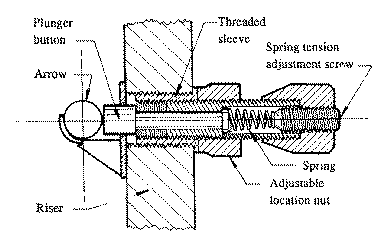
A pressure button can be used when the bow riser has a threaded
sleeve fitted.
The arrow rest has to be adjusted so that the centre of the arrow and the
centreline of the pressure button align.
The pressure button has two purposes:
- The first is to adjust the horizontal position of the arrow as it sits on
the arrow rest to achieve 'centre shot'.
- The second is to absorb the initial bend of the arrow as it is released by
adjusting the amount of spring pressure on the plunger button.
These adjustments will achieve straighter arrow flight when the bow is
'tuned'.
Technical Terms for
Beginners
Click here to see a diagram of a bow with labelled parts.



